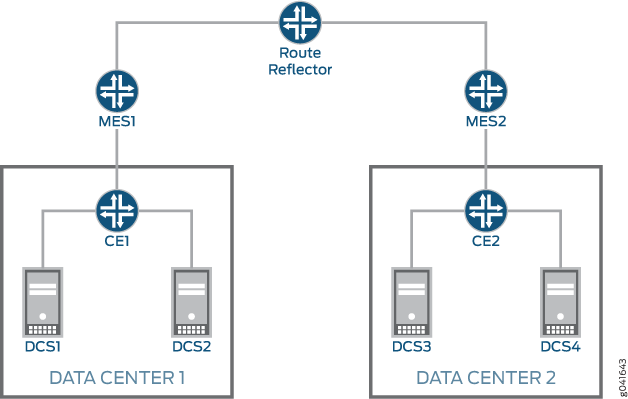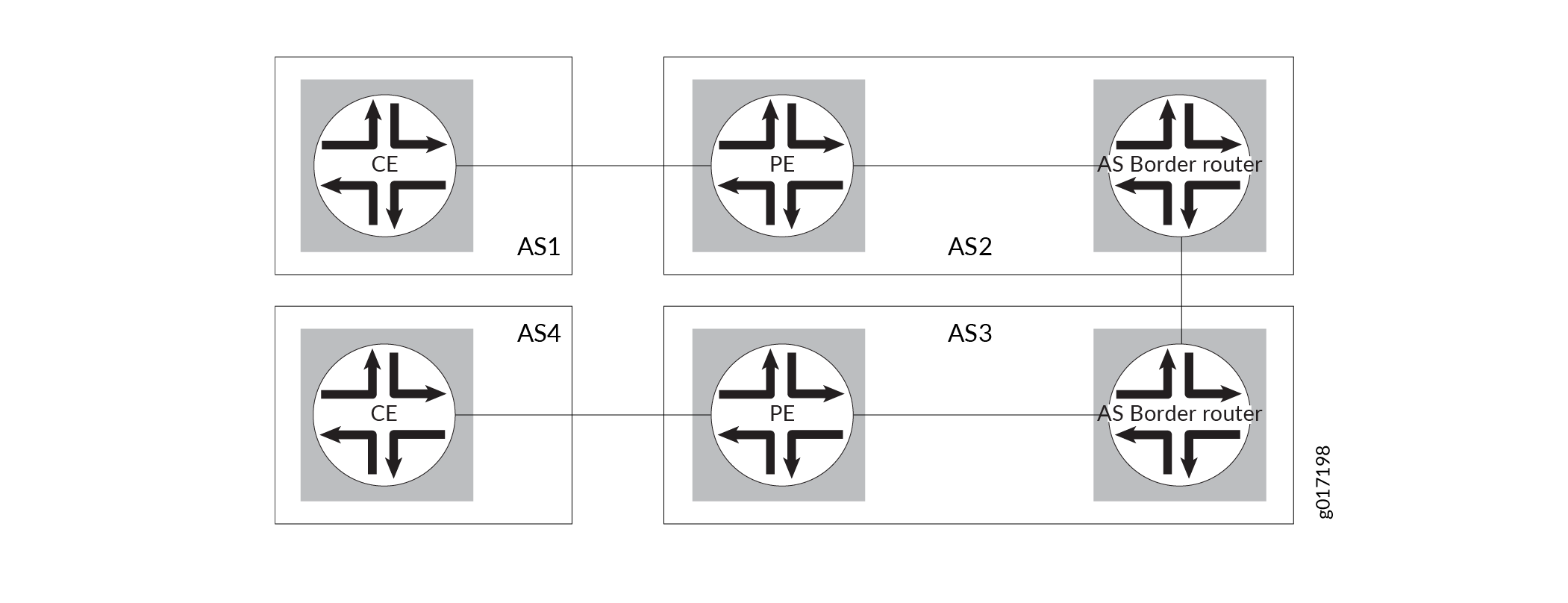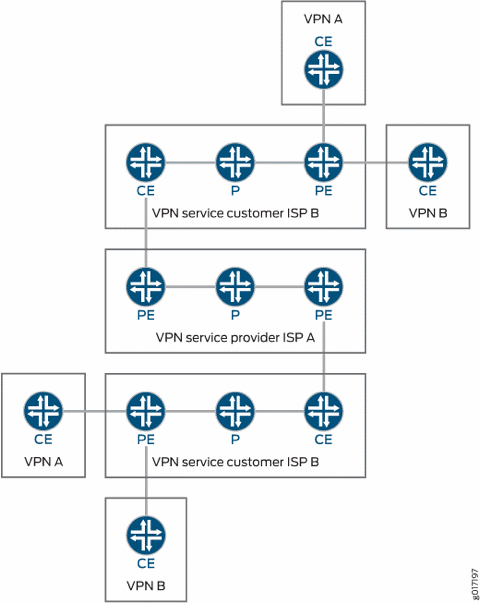Junos Fusion Provider Edge Supported Protocols
Junos Fusion Provider Edge expands the number of available network interfaces on an aggregation device by connecting satellite devices that act as extensions of the aggregation device. The entire system—the interconnected aggregation device and satellite devices—is called a Junos Fusion. Junos Fusion Provider Edge simplifies network aggregation device administration because the aggregation device acts as a single, port-dense device, managed using one IP address.
Layer 3 Protocols Supported on Junos Fusion Provider Edge
Starting with Junos OS Release 14.2R4, many of the routing protocols supported on MX Series routers have been extended to the satellite devices in a Junos Fusion Provider Edge topology. You can configure the following Layer 3 routing protocols on satellite device extended ports:
-
BFD (Centralized only)
-
BGP
-
BGP for IPv6
-
IS-IS
-
OSPF
-
OSPF version 3
-
LACP
- Segment Routing
You can configure the following Layer 3 routing protocols on satellite device extended ports that are included in link aggregation groups (LAGs):
-
BGP
-
IS-IS
-
OSPF
-
LACP
- BFD Support on Junos Fusion Provider Edge
- BGP Support on Junos Fusion Provider Edge
- IS-IS Support on Junos Fusion Provider Edge
- OSPF Support on Junos Fusion Provider Edge
- LACP Support on Junos Fusion Provider Edge
- Segment Routing
BFD Support on Junos Fusion Provider Edge
Bidirectional Forwarding Detection (BFD) is a protocol used to detect failure in the data path. Hello packets are sent at a specified, regular interval. A neighbor failure is detected when the routing device stops receiving a reply after a specified interval. BFD works with a wide variety of network environments and topologies.
Junos Fusion Provider Edge only supports centralize BFD with the
no-delegate-processing statement included in the [edit
routing-options ppm] hierarchy. LACP does not work when
no-delegate-processing is enabled.
For more information, see the following:
BGP Support on Junos Fusion Provider Edge
Border Gateway Protocol (BGP) is a standardized exterior gateway protocol that exchanges routing and reachability information between autonomous systems on the Internet. The protocol can be a path vector protocol or a distance-vector routing protocol. BGP makes routing decisions based on paths, network policies, or rule-sets configured by a network administrator for core routing decisions. For more information, see the BGP User Guide and the CLI statement bgp.
IS-IS Support on Junos Fusion Provider Edge
Intermediate System to Intermediate System (IS-IS) moves information within either a computer network, a group of physically connected computers, or between similar devices. It accomplishes this by determining the best route for traffic through a packet-switched network. For more information, see the IS-IS User Guide.
OSPF Support on Junos Fusion Provider Edge
Open Shortest Path First (OSPF) is a routing protocol for IP networks using a link state routing algorithm. This interior routing protocol operates within a single autonomous system. For more information, see the OSPF User Guide and the CLI statements ospf and ospf3.
LACP Support on Junos Fusion Provider Edge
Link Aggregation Contol Protocol (LACP) is one method of bundling several physical interfaces to form one logical aggregated Ethernet interface. For more information , see Understanding Link Aggregation and Link Aggregation Control Protocol in a Junos Fusion and Configuring Aggregated Ethernet Interfaces.
Segment Routing
Segment routing (SR) is a source-based routing technique that simplifies traffic engineering and management across network domains. It removes network state information from the transit routers and nodes in the network and places the path state information into packet headers at an ingress node. Segment routing traffic engineering (SR-TE) uses policies to steer traffic through the network. When you configure segment routing, keep in mind that the extended ports on satellite devices can only be configured as customer edge (CE) router interfaces. Table 1 lists the supported segment routing features on Junos fusion for provider edge:
| Features | Additional Information |
|---|---|
| SR and SR-TE for Intermediate System-to-Intermediate System | Understanding Source Packet Routing in Networking (SPRING) |
| Layer 2 Circuits, Layer 2 VPNs, VPLS over SR-ISIS and uncolored SR-TE | Static Segment Routing Label Switched Path |
| Layer 3 VPNs over SR-ISIS and color and Uncolored SR-TE | Static Segment Routing Label Switched Path |
| Hierarchical Class of Service of VPNs over Segment Routing | Understanding CoS on an MX Series Aggregation Device in Junos Fusion Provider Edge |
| EVPN MPLS with single-active and all -active multihoming redundancy. | Segment Routing Traffic Engineering at BGP Ingress Peer Overview |
Multicast Protocols Supported on Junos Fusion Provider Edge
You can configure the following multicast protocols on satellite device extended ports:
- PIM on Junos Fusion Provider Edge
- IGMP on Junos Fusion Provider Edge
- MLD on Junos Fusion Provider Edge
- BGP MVPN on Junos Fusion Provider Edge
PIM on Junos Fusion Provider Edge
Protocol-Independent Multicast (PIM) is a family of multicast routing protocols for Internet Protocol (IP) networks that provide one-to-many and many-to-many distribution of data over a LAN, WAN or the Internet. It is termed protocol-independent because PIM does not include its own topology discovery mechanism, but instead uses routing information supplied by other routing protocols, in this case Internet Group Management Protocol (IGMP) on extended ports. All four PIM modes work on extended ports—PIM sparse Mode (default), PIM dense Mode, bidirectional PIM, and PIM source-specific multicast.For more information, see the PIM Overview and the CLI statement pim.
IGMP on Junos Fusion Provider Edge
Internet Group Management Protocol (IGMP) is a communications protocol used by hosts and adjacent routers on IPv4 networks to establish multicast group membership. IGMP is an integral part of IP multicast, and is used for one-to-many networking applications such as online streaming video and gaming because it allows more efficient use of resources when supporting these types of applications. For more information, see Understanding IGMP and the CLI statement igmp.
MLD on Junos Fusion Provider Edge
Multicast Listener Discovery (MLD) is a component of the Internet Protocol Version 6 (IPv6) suite. MLD is used by IPv6 routers for discovering multicast listeners on a directly attached link, much like IGMP is used in IPv4. MLD uses ICMPv6 messaging in contrast to IGMP's bare IP encapsulation. For more information, see the mld CLI statement.
Junos Fusion supports multicast and broadcast packet replication on the aggregation device and the satellite devices. For more information on multicast replication, see Understanding Multicast Replication in a Junos Fusion.
BGP MVPN on Junos Fusion Provider Edge
BGP multicast VPN (MVPN) is a method for implementing multiprotocol multicast services on a BGP MPLS Layer 3 VPN. BGP MVPNs use existing BGP and MPLS VPN infrastructure to support multicast traffic between sets of senders and sets of receivers. Junos Fusion supports the connection of BGP-based multicast VPN CE devices on the extended ports of the satellite device. For more information, see Configuring BGP MVPNs.
VPN Protocols Supported on Junos Fusion Provider Edge
You can configure the following VPN protocols on satellite device extended ports:
Extended ports on satellite devices can only be configured as customer edge (CE) router interfaces in a VPN. Provider edge (PE) router interfaces must be configured directly on the native port of the aggregation device.
- Layer 2 Circuits on Junos Fusion Provider Edge
- Layer 2 VPNs on Junos Fusion Provider Edge
- Layer 3 VPNs on Junos Fusion Provider Edge
- DHCP Relay Support on Layer 3 VPNs
- VPLS on Junos Fusion Provider Edge
- EVPN with VXLAN
- EVPN-MPLS
- Interprovider and Carrier-of-Carrier VPNs
Layer 2 Circuits on Junos Fusion Provider Edge
You can configure a local switching interface to ignore the MTU configuration set for an associated physical interface. This enables you to bring up a circuit between two logical interfaces that are defined on physical interfaces with different MTU values. For more information, see the Configuring Interfaces for Layer 2 Circuits Overview.
Layer 2 VPNs on Junos Fusion Provider Edge
Layer 2 VPNs provide communication between a provider network and a customer network. Provider edge routers or PEs at the edge of a provider network communicate with each customer edge or CE router. Customers configure their routers to carry all Layer 3 traffic, while the service provider needs to know only how much traffic the Layer 2 VPN needs to carry. For more information, see the Layer 2 VPNs and VPLS User Guide for Routing Devices.
Layer 3 VPNs on Junos Fusion Provider Edge
Layer 3 VPNs also provide communication between a provider network and a customer network. However, in a Layer 3 VPN, routing occurs on the service provider’s router. Therefore, Layer 3 VPNs require more configuration on the part of the service provider, because the service provider’s PE routers must store and process the customer’s routes. For more information, see the Layer 3 VPNs User Guide for Routing Devices.
DHCP Relay Support on Layer 3 VPNs
Dynamic Host Configuration Protocol (DHCP) is a network management protocol that is used to dynamically assign IP addresses and other related configuration information to network devices. The DHCP server automatically assigns IP addresses and other network parameters to client devices on the network. DHCP Relay Agent forwards the DHCP messages between the DHCP clients and the DHCP servers when the servers and clients are on different networks. Junos fusion for provider edge supports DHCP relay on EVPN-MPLS networks. It is not supported on an EVPN-MPLS network over segment routing. For more information, see DHCP Relay Agent.
VPLS on Junos Fusion Provider Edge
Virtual Private LAN Service (VPLS) provides Ethernet-based multipoint to multipoint communication over IP or MPLS networks. It allows geographically dispersed sites to share an Ethernet broadcast domain by connecting sites with pseudowires. The technologies that can be used as pseudowire can be Ethernet over MPLS, L2TPv3 or even GRE. For more information, see the Layer 2 VPNs and VPLS User Guide for Routing Devices.
EVPN with VXLAN
You can configure ports on the satellite devices managed by MX Series routers to support Ethernet VPNs (EVPNs) with Virtual Extensible LAN (VXLAN) encapsulation. EVPN provides layer 2 VPN services with advance multi-homing capabilities by using the BGP control plane to distribute routes over IP or IP/MPLS backbone. VXLAN is a tunneling scheme that overlays layer 2 ethernet frames on top of layer 3 UDP packets. EVPN with VXLAN encapsulation allows you to create a logical network for hosts that span across a physical network and supports up to 16 million VXLAN segments. For more information on EVPN and VXLAN, see Understanding EVPN with VXLAN Data Plane Encapsulation.
EVPN-MPLS
An Ethernet VPN (EVPN) enables you to connect dispersed customer sites using a Layer 2 virtual bridge. EVPN-MPLS extends layer 2 VPN services over an MPLS network. It consists of customer edge (CE) devices connecting to MPLS edge switches, often provider edge (PE) devices that provide MPLS label functionality, EVPN-MPLS Junos Fusion Provider Edge supports connecting a customer edge (CE) on the extended ports of the satellite device. Figure 1 shows a typical EVPN deployment. For more information on EVPN-MPLS, see EVPN Overview.

Interprovider and Carrier-of-Carrier VPNs
Interprovider VPNs provide connectivity between separate ASs. This functionality is used by a VPN customer who has connections to several different service providers, or different connections to the same service provider in different geographic regions, each of which has a different AS. For Interprovider VPNs, Junos Fusion only supports intra-AS connection on a Autonomous System Border Router (ASBR) to the extended port. For example, in Figure 2, extended ports can only be used on the ASBR towards the PE router within each AS.

Carrier-of-Carrier VPN service describes a hierarchical VPN (also known as a recursive VPN) model where one carrier (VPN service customer) transports their VPN traffic inside another carrier’s VPN (VPN service provider). Figure 3 shows the carrier-of-carrier model with a VPN service provider (ISP A) and a VPN service customer (ISP B). The VPN service provider is the backbone network carrier and provides VPN support for the VPN service customers. Junos Fusion PE currently supports PE routers for VPN service customers. In 21.1R1, Junos Fusion PE also supports PE routers for VPN service providers. VPN-IPv4 addresses for the VPN service customer are treated as external routes by the VPN service provider and are not imported into the VPN service provider’s VRF table. The VPN service provider uses MPLS to route the VPN traffic, so it must be configured on the VPN service provider network. The VPN service customer only needs to configure MPLS in the CE device that is connected to the PE device of the VPN service provider. You can connect routers for Internet Service Provider as the customer and VPN Service Provider as the customer on the extended port.

Junos Fusion Provider Edge supports 6vPE in both interprovider and carrier-of-carrier VPNs. For more information, see Interprovider and Carrier-of-Carriers VPNs.
